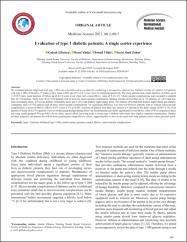| dc.contributor.author | Elbüken, Gülşah | |
| dc.contributor.author | Yıldız, Resul | |
| dc.contributor.author | Yıldız, İsmail | |
| dc.contributor.author | Zuhur, Sayid Shafi | |
| dc.date.accessioned | 2022-05-11T14:13:59Z | |
| dc.date.available | 2022-05-11T14:13:59Z | |
| dc.date.issued | 2021 | |
| dc.identifier.issn | 2147-0634 | |
| dc.identifier.issn | 2147-0634 | |
| dc.identifier.uri | https://doi.org/10.5455/medscience.2020.04.067 | |
| dc.identifier.uri | https://app.trdizin.gov.tr/makale/TkRFNE9UVTJOZz09 | |
| dc.identifier.uri | https://hdl.handle.net/20.500.11776/5731 | |
| dc.description.abstract | We evaluated patients diagnosed with type 1 DM who were followed at our clinic by conducting a retrospective chart review. Medical records of a total of 147 patientswith type 1 DM (70 females, 77 males) with a mean (±SD) age of 31.2±9.7 years were reviewed retrospectively. The study patients had a mean duration of follow-up of13.9±9.5 years, mean duration of follow-up of 4±2.6 years at our clinic and a mean HbA1c value of 8.3±2.1%. Microvascular complications were recorded in medicalfiles for 128 patients. There were 48 (37.5%) patients with at least one microvascular complication. Medical records showed that out of 128 patients, 23 (18%) had diabeticneuropathy alone, 4(3%) had diabetic retinopathy alone and 5 (4%) had diabetic nephropathy alone. Ten patients (8%) had both diabetic nephropathy and diabeticretinopathy and 6 (4.7%) patients had all three microvascular complications. No significant difference was observed between patients with or without microvascularcomplications in terms of HbA1c (HbA1c 8.3% versus 8.1%; p=0.85). A history of diabetic foot ulcer was present in 4 patients in the study sample (4/147=2.7% of allpatients).Twenty-two (15%) patients were on insulin pump therapy during follow-up. Insulin pump users had a significantly lower HbA1c value (7.9%) compared to thosenot using insulin pump (8.5%) (p=0.02). At our clinic, special efforts are being made to ensure type 1 diabetic individuals have regular outpatient examinations. Despiteall these measures, our patients are still far from reaching their target HbA1c values, suggesting that we have to do much more help patients achieve their glycemic goals. | en_US |
| dc.language.iso | eng | en_US |
| dc.identifier.doi | 10.5455/medscience.2020.04.067 | |
| dc.rights | info:eu-repo/semantics/openAccess | en_US |
| dc.title | Evaluation of type 1 diabetic patients: A single center experience | en_US |
| dc.type | article | en_US |
| dc.relation.ispartof | Medicine Science | en_US |
| dc.department | Fakülteler, Tıp Fakültesi, Dahili Tıp Bilimleri Bölümü, İç Hastalıkları Ana Bilim Dalı | en_US |
| dc.department | Fakülteler, Tıp Fakültesi, Temel Tıp Bilimleri Bölümü, Biyoistatistik Ana Bilim Dalı | en_US |
| dc.identifier.volume | 10 | en_US |
| dc.identifier.issue | 1 | en_US |
| dc.identifier.startpage | 60 | en_US |
| dc.identifier.endpage | 63 | en_US |
| dc.institutionauthor | Elbüken, Gülşah | |
| dc.institutionauthor | Yıldız, Resul | |
| dc.institutionauthor | Yıldız, İsmail | |
| dc.institutionauthor | Zuhur, Sayid Shafi | |
| dc.identifier.trdizinid | TkRFNE9UVTJOZz09 | en_US |



















